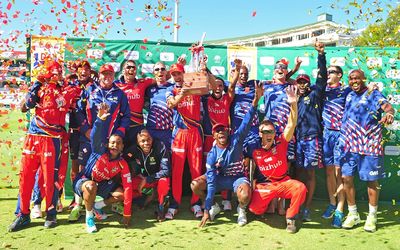Transformation is good and necessary, but the rules need to be improved
by Neil Manthorp,
2016-03-01 05:49:01.0
THE Lions were delighted and deserved winners of the Momentum One-Day Cup at Newlands on Sunday, adding yet another feather to the coaching cap worn with such aplomb by Geoffrey Toyana. Higher honours beckon — if he remains ambitious for them.
The Lions have differed from the other five franchises this year by occasionally adopting a different formation on the field. Whereas the other five have routinely lined up in a 5-3-3 (batsmen, all-rounders, bowlers) shape, the Gautengers have occasionally started with a 4-3-4 line-up.
Last season and before that, when Cricket SA’s selection requirement had only two categories, the most common XI was the old-fashioned 7-4 formation, although the Lions, Cobras and Warriors all fielded teams at some stage with the balance significantly changed to 5-6 and even 4-7.
The moment teams with these new formations walked onto the field, the topic of quotas became obsolete.
Today, however, because of the proliferation of 5-3-3 teams, it is a hotter topic than ever. Players are more distrusting than ever, and not just about their teammates, but themselves. Inevitably, the onfield chatter between opposing teams is reflecting the formation being used.
It is a waste of emotional time and energy wishing for the days of unenhanced selection. Transformation is not some sort of necessary evil, or something that has to be tolerated; it is a good and necessary process, which will benefit everyone eventually, despite the difficulty and pain it may cause along the way.
Some will give up even trying to make a career in the game, others will retire prematurely and others will move, as 18-year-old fast bowler Conor McKerr did yesterday, when he signed a three-year contract with English county Surrey and effectively dedicated his career to that country just a couple of months after representing SA at the under-19 World Cup.
McKerr has both a British and a South African passport, so he had that option. The vast majority of South African cricketers have no such luxury unless they fancy relocating 12,000km away and are lucky enough to get a contract and a chance to make a career in New Zealand.
There are two steps to improving the situation in SA that will stop, or at least significantly lessen, the considerable unhappiness among the players.
The first is to make provincial and franchise selectors really work for their money and, consequently, start changing the 5-3-3 format that is just so unnatural.
There should not be less transformation, but it should be implemented by men and women who understand the game. If their aim is to have the game in general more representative of the country, does insisting on numbers in every single XI that takes the field really help? It would make a heap more cricketing sense if the target were achieved at the end of the season.
That way, coaches and selectors can take account of individuals’ form and injuries, the strengths and weaknesses of the opposition, the format of the competition, and can even manufacture home-pitch conditions to suit their strengths.
The more the playing format can be changed, and the more 4-2-5, 4-5-2 and 3-4-4 playing XIs we have on the field, the more comfortable the players will be with both the concept and implementation of transformation. It makes so much more sense for franchises to be issued with a "target" of 50 or 60 places in starting XIs through the course of a season than to expect, at this early stage, every franchise to be able to field a balanced team with their best players in every single match.
The second aspect of change is the number of franchises. This season, there have been half-a-dozen Proteas from the past 12 months who have been unable to get a game for their franchises. In all, more than 20 nationally capped players have been left out of one format or another for reasons other than form or fitness. That’s an awful lot of talent sitting on the bench.
Border and Griquas were so desperate to have their own franchises a decade ago, they were prepared to go to court. Perhaps now is their time, although North West, Easterns, and even Boland, could make strong cases for a promotion from the amateur to the professional ranks.
Whoever it is and wherever it happens, SA needs to widen its top-tier playing base for transformation to strengthen, not weaken the national game.
The quota system was imposed by administrators and politicians without consultation with captains, coaches and selectors. What if cricket, collectively, said, "We didn’t do enough, or quickly enough, to transform our game and we apologise for that. But now we’d like to make it happen in a way that might really work."
Would the politicians listen? Or care?

Lions celebrate their One-Day Cup final victory over the Cobras at Newlands yesterday. Picture: RYAN WILKISKY/BACKPAGEPIX
THE Lions were delighted and deserved winners of the Momentum One-Day Cup at Newlands on Sunday, adding yet another feather to the coaching cap worn with such aplomb by Geoffrey Toyana. Higher honours beckon — if he remains ambitious for them.
The Lions have differed from the other five franchises this year by occasionally adopting a different formation on the field. Whereas the other five have routinely lined up in a 5-3-3 (batsmen, all-rounders, bowlers) shape, the Gautengers have occasionally started with a 4-3-4 line-up.
Last season and before that, when Cricket SA’s selection requirement had only two categories, the most common XI was the old-fashioned 7-4 formation, although the Lions, Cobras and Warriors all fielded teams at some stage with the balance significantly changed to 5-6 and even 4-7.
The moment teams with these new formations walked onto the field, the topic of quotas became obsolete.
Today, however, because of the proliferation of 5-3-3 teams, it is a hotter topic than ever. Players are more distrusting than ever, and not just about their teammates, but themselves. Inevitably, the onfield chatter between opposing teams is reflecting the formation being used.
It is a waste of emotional time and energy wishing for the days of unenhanced selection. Transformation is not some sort of necessary evil, or something that has to be tolerated; it is a good and necessary process, which will benefit everyone eventually, despite the difficulty and pain it may cause along the way.
Some will give up even trying to make a career in the game, others will retire prematurely and others will move, as 18-year-old fast bowler Conor McKerr did yesterday, when he signed a three-year contract with English county Surrey and effectively dedicated his career to that country just a couple of months after representing SA at the under-19 World Cup.
McKerr has both a British and a South African passport, so he had that option. The vast majority of South African cricketers have no such luxury unless they fancy relocating 12,000km away and are lucky enough to get a contract and a chance to make a career in New Zealand.
There are two steps to improving the situation in SA that will stop, or at least significantly lessen, the considerable unhappiness among the players.
The first is to make provincial and franchise selectors really work for their money and, consequently, start changing the 5-3-3 format that is just so unnatural.
There should not be less transformation, but it should be implemented by men and women who understand the game. If their aim is to have the game in general more representative of the country, does insisting on numbers in every single XI that takes the field really help? It would make a heap more cricketing sense if the target were achieved at the end of the season.
That way, coaches and selectors can take account of individuals’ form and injuries, the strengths and weaknesses of the opposition, the format of the competition, and can even manufacture home-pitch conditions to suit their strengths.
The more the playing format can be changed, and the more 4-2-5, 4-5-2 and 3-4-4 playing XIs we have on the field, the more comfortable the players will be with both the concept and implementation of transformation. It makes so much more sense for franchises to be issued with a "target" of 50 or 60 places in starting XIs through the course of a season than to expect, at this early stage, every franchise to be able to field a balanced team with their best players in every single match.
The second aspect of change is the number of franchises. This season, there have been half-a-dozen Proteas from the past 12 months who have been unable to get a game for their franchises. In all, more than 20 nationally capped players have been left out of one format or another for reasons other than form or fitness. That’s an awful lot of talent sitting on the bench.
Border and Griquas were so desperate to have their own franchises a decade ago, they were prepared to go to court. Perhaps now is their time, although North West, Easterns, and even Boland, could make strong cases for a promotion from the amateur to the professional ranks.
Whoever it is and wherever it happens, SA needs to widen its top-tier playing base for transformation to strengthen, not weaken the national game.
The quota system was imposed by administrators and politicians without consultation with captains, coaches and selectors. What if cricket, collectively, said, "We didn’t do enough, or quickly enough, to transform our game and we apologise for that. But now we’d like to make it happen in a way that might really work."
Would the politicians listen? Or care?




















Change: -1.52%
Change: -1.67%
Change: -1.69%
Change: -1.65%
Change: -1.46%
Data supplied by Profile Data
Change: -0.74%
Change: 0.12%
Change: -1.52%
Change: 0.00%
Change: 0.10%
Data supplied by Profile Data
Change: 0.54%
Change: -0.20%
Change: 0.47%
Change: 0.81%
Change: 1.05%
Data supplied by Profile Data
Change: 0.84%
Change: 0.31%
Change: 0.44%
Change: 0.17%
Change: 0.19%
Data supplied by Profile Data